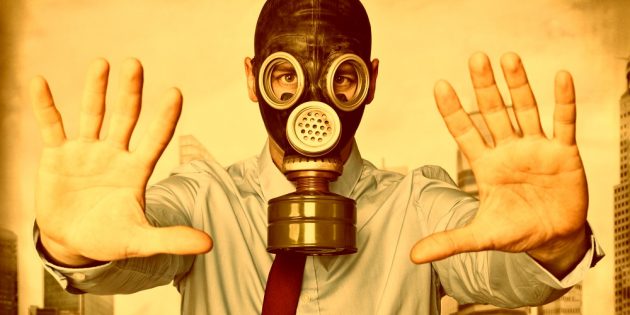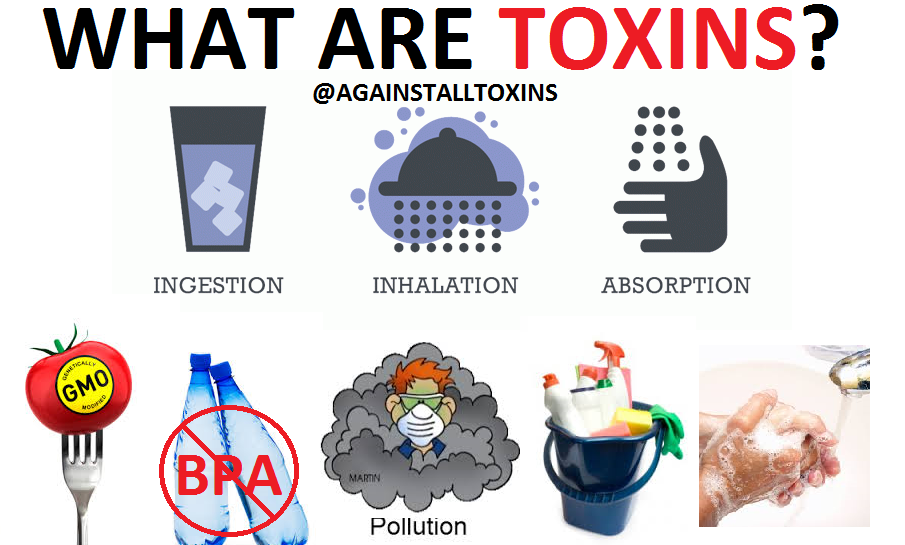Each day, we are surrounded by poisonous substances, which affect our minds and bodies. These poisonous substances are called toxins and your health is affected much more than you may realize depending upon how much exposure you have to toxins on a regular basis.
Toxicants and Toxins come in all shapes and sizes, and while they can come from both natural and human-made sources, there are normally three types of toxic entities; chemical, biological, and physical:
- Chemical toxicants include inorganic substances such as lead, mercury, hydrofluoric acid, and chlorine gas, and organic compounds such as methyl alcohol , most medications, and poisons from living things.
- Biological toxicants include bacteria and viruses that can induce disease in living organisms. Biological toxicity can be difficult to measure because the "threshold dose" may be a single organism. Theoretically one virus, bacterium or worm can reproduce to cause a serious infection.
- Physical toxicants are substances that, due to their physical nature, interfere with biological processes. Examples include coal dust, asbestos fibers or finely divided silicon dioxide , all of which can ultimately be fatal if inhaled. Corrosive chemicals possess physical toxicity because they destroy tissues, but they're not directly poisonous unless they interfere directly with biological activity.
Depending on the ways of intruding into our body toxins are divided into two major groups:
- Entered from outside (exotoxin/external/exotoxins) and
- Accumulated within the body (endotoxins/internal /metabolic).
- Exotoxins Toxins: (Environmental) Sometimes called exogenous (made outside your body) toxins, environmental toxins include all the chemicals and pollutants that you're exposed to through air, water, and food. Common environmental toxins include pesticides, herbicides, prescription and over-the-counter medications, carbon monoxide, triclosan, bisphenol A, phthalates, and volatile organic compounds. Exotoxins consumed with food, water, drugs, 1st & 2nd generation vitamins, nicotine and alcohol, with the exhaust gases and cosmetics, etc
- Metabolic Toxins: (Endotoxins) Sometimes called endogenous (made inside your body) toxins, metabolic toxins are produced by each of your cells as they go about their everyday metabolic processes.
Metabolic or Endotoxins referred to
• by-products of cellular metabolism (autotoxins) and activity of various microorganisms (exotoxins);
• hereditary toxins (neurotoxins) that enter the body during fetal development;
• toxins caused by psycho factors (negative emotions, emotional imbalances, stresses, etc.).
Technically speaking, there is a third category of toxins, known as autogenous toxins. These are the toxins that one is born with, in the form of pathogens or toxic compounds, largely from environmental/dietary exposure over many generations. These are usually passed down from the maternal line, from the mother to the baby in the womb. However, these are in a sense just exogenous toxins that happen to be absorbed from the mother rather than from the environment.
Types Of Environmental Toxins
As stated before, there’s a large variety of toxicants in the environment. To better understand them, we can put them into precise categories that are based on the types of problems they cause.
- Carcinogens are probably the best-known toxicant because these are cancer-causing chemicals. Cigarette smoke falls into this category as it contains over 4,000 chemicals, many of which cause cancer.
- Mutagens are mutation-causing chemicals. When organisms are exposed to a mutagen, it literally mutates their DNA, leading to cancer and other disorders. X-rays are well known mutagens.
- Teratogens are chemicals that cause harm to unborn babies. The name of this toxicant comes from the Greek word teras, which means monster. These chemicals cause birth deficiencies during development in the womb. Thalidomide was used in the 1950s as a sleeping pill and to prevent nausea during pregnancy, but turned out to be a very harmful teratogen. Even a single dose is potent enough to cause severe birth defects in children.
- Allergens are chemicals that stimulate over activity in the immune system. When you are exposed to allergens, your body goes into overdrive, activating an immune response to try and get rid of the allergen. This is the reason pollen and dust cause symptoms that are similar to being sick.
- Neurotoxins are chemicals that attack the nervous system. These include heavy metals, like lead and mercury, as well as pesticides and chemical weapons. Neurotoxins can lead to symptoms like slurred speech, loss of muscle control and even death.
- Endocrine disrupters are chemicals that disturb the endocrine system in organisms and most often come from prescription drugs and chemicals in plastics. The endocrine system is also known as the hormone system, and this part of your body is what regulates growth, development, sexual maturity, brain function and even appetite.
Toxicants that disrupt hormone functioning can lead to some severe problems because they so closely resemble real hormones in your body. Reptiles and amphibians are particularly sensitive to endocrine disrupters and exposure often leads to feminization of male animals. This may seem like a lot to remember! But if you look closely, you’ll see that the name of the toxicant describes the effect it has on organisms, which helps us understand these toxicants better.
Also toxins can be categorized according to the location of the body and where their effects are most prominent:
- Hemotoxins (for example, found in some snakes) destroy red blood cells and cause general tissue damage.
- Hemotoxins (for example, found in some snakes) destroy red blood cells and cause general tissue damage.
- Phototoxins (for example, alpha-terthienyl found in marigold plants) cause allergic reactions in susceptible individuals.
- Necrotoxins (for example, necrotising fasciitis – flesh-eating bacteria) destroy cells they encounter and cause general tissue damage.
- Neurotoxins (for example, tetrodotoxin found in pufferfish and some grey side-gilled sea slugs) affect the nervous system of organisms.
Organic And Inorganic Toxins
When classifying by chemical origin we have organic and inorganic toxins:
- Inorganic Chemical Toxins
Toxic Elements, e.g. heavy metals - mercury, arsenic, cadmium, etc.
Toxic Element Salts, e.g. Mercuric Sulphate, Mercuric Oxide, etc.
Ammonia, e.g. cigarette smoke
Preservatives, e.g. nitrites. Nitrites are themselves considered toxic in concentrations over 200ppm, which is the recommended limit for Sodium Nitrite, a common preservative in cured meats, like bacon, and also in cheese products and processed meats such as sausages. Nitrosamines can be formed when the nitrites in cured meats react with the downstream products of amino acids (i.e. secondary amines), particularly in the acidic environments of the stomach. Nitrosamines are carcinogenic (and are linked to bowel cancer). High temperatures, e.g. frying can also escalate the rate of formation of nitrosamines in meat. Nitrosamines are linked to bowel cancer. Nitrosamines are also found in beer, fish, fish by-products, tobacco smoke and latex products (e.g. condoms - in very low concentrations).
- Organic Chemical Toxins
It is estimated that the body is exposed to over 200 different synthesized (organic) chemicals per day from toiletry products, cosmetics and food additives. Some of the substances are not that toxic, but can tend to attach themselves to cell membranes and interfere with biochemical processes. Others more directly interfere with the endocrine system and biochemical processes.
- Certain Petroleum and Petrochemical/Synthetic Chemical Derivatives and Plastics
- Tar from cigarettes and other smoked herbs; also passive smoking, e.g. parents smoking in front of children (in house, in car, outside etc.); inhaling smoke from jossticks lit by misguided massage practitioners or those giving a tai chi or yoga class etc. to create a 'relaxing' atmosphere (try opening a window, using essential oils or keeping plants in the room, all of which do not poison your guests/clients). All burning of organic compounds produces tar which damages the lungs.
- Rogue fatty acids, e.g. transfats from baked goods and fried food.
- Pesticides (organic component of)
- Herbicides (organic component of)
- Preservatives
- Artificial Colourings
- Artificial Stabilisers
- Artificial Thickeners, e.g. MSG
- Antibiotics
- Anti-depressants
- Certain toxic or carcinogenic chemical compounds found in bathroom products and cosmetics, e.g. after shave, eau de toilette, skin creams, shampoos, etc.
- Biotoxins
- PCBs (Printed Circuit Boards)
- Organic Heavy Metals (heavy metals bonded to amino acids)
- Formaldehyde, e.g. cigarette smoke
- Benzene (gaseous) and other petrochemicals given off by the operation of photocopiers and printers (i.e. laserjet, inkjet) in office environments, exaccerbated where there is poor ventilation and fresh air. Next time you use your laserjet print, try inhaling close to it and notice the smell and see how good it makes you feel!
- Toxins found in laundry detergents
- Carcinogenic compounds formed by unsound cooking methods, deep frying or burning
- Synthesized and naturally occurring (often oil based) drugs, e.g. THC, LSD etc.
- And more
Many western governments are finally introducing new chemical controls as part of the 2006 Strategic Approach to International Chemical Management agreement. Leading the way is the European Union, with a new program called REACH (Regulation on Registration, Evaluation, Authorization and Restriction of Chemicals) that necessitates industry to prove the safety of their chemicals and consumer products before they reach the market.
But with the sheer number of toxic chemicals on the market already – all without any major bungle or testing for safety until after the fact – it’s no wonder we are not as healthy as we could be.
You may also like:
What Are The Signs And Symptoms Of Toxicity?
Understanding Toxins and Toxicity




